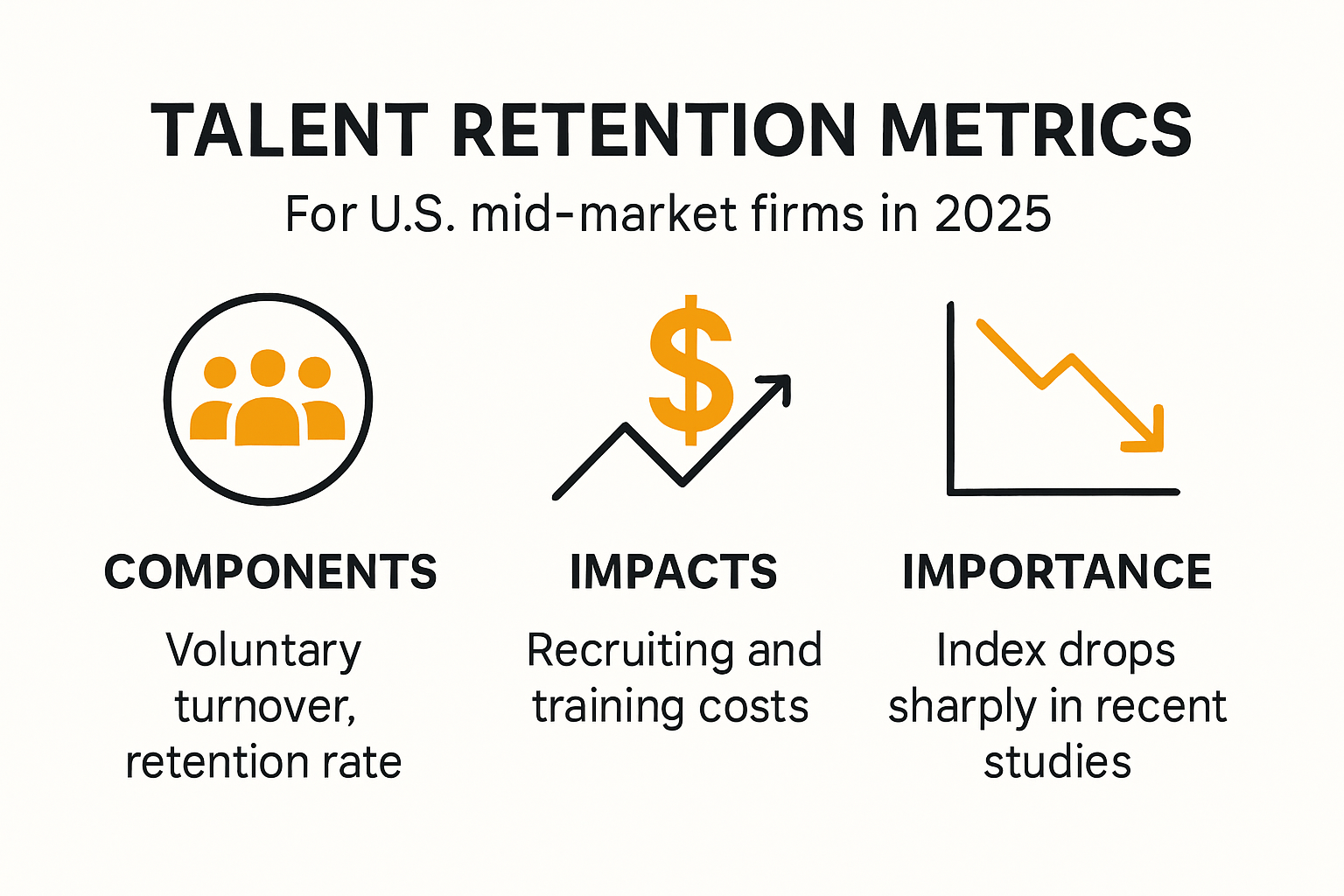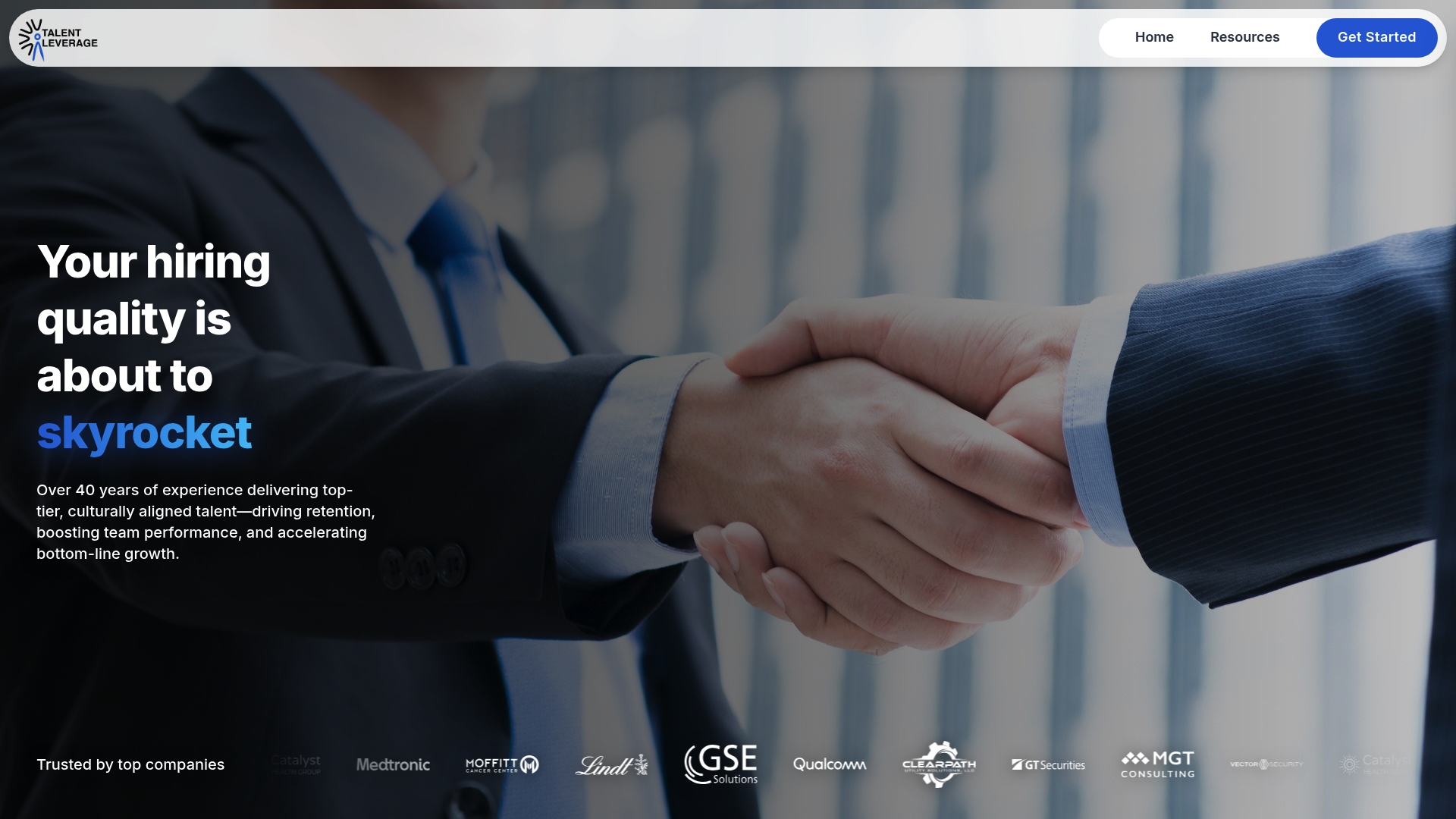
Talent retention is shaping up to be the top challenge for US mid-market companies in 2025. Here’s something you might not expect. The Employee Retention Index fell 6.2 points, its sharpest drop in two years, exposing a level of organizational risk that many firms simply haven’t planned for. Most companies obsess over hiring, yet overlook the real power of thoughtful retention metrics. Miss this shift and you risk not just higher costs but an invisible drain on your team’s drive and knowledge base.
Table of Contents
- Why Talent Retention Metrics Matter Most In 2025
- Key Metrics Every US Middle Market Company Should Track
- Industry Benchmarks And Regional Comparisons
- Actionable Steps To Improve Retention Outcomes
Quick Summary
| Takeaway | Explanation |
|---|---|
| Urgent Need for Metrics | Talent retention metrics are essential for mid-market firms to navigate workforce dynamics effectively and ensure organizational health and stability. |
| Focus on Predictive Analytics | Companies should leverage advanced predictive analytics to anticipate turnover risks and develop proactive intervention strategies to enhance retention. |
| Track Comprehensive Performance Indicators | Key metrics like turnover rate, employee engagement scores, and time to replacement provide crucial insights into retention challenges and opportunities for improvement. |
| Address Regional and Demographic Variations | Understanding demographic and sectoral retention differences is vital for tailoring retention strategies that resonate with specific workforce segments and regions. |
| Implement Development and Cultural Strategies | Investing in professional development and nurturing a positive organizational culture significantly boosts employee retention and overall business profitability. |
Why Talent Retention Metrics Matter Most in 2025
Talent retention metrics represent far more than numerical indicators in 2025. They serve as critical diagnostic tools revealing deep insights into organizational health, workforce stability, and strategic human capital management. Mid-market firms confronting unprecedented workforce dynamics must understand these metrics as strategic navigational instruments guiding critical talent decisions.
The Financial Impact of Employee Turnover
The economic consequences of talent churn are staggering. According to Eagle Hill Consulting, the Employee Retention Index experienced its largest drop in two years, falling 6.2 points. This dramatic decline signals heightened organizational vulnerability. Hidden turnover costs extend beyond simple replacement expenses, encompassing lost productivity, institutional knowledge drain, and disrupted team dynamics.
Moreover, research indicates that an astonishing 42% of employee turnover is preventable. Yet, only 11% of HR professionals actively measure the comprehensive financial impact of workforce attrition. This data underscores a critical gap in strategic talent management approaches.

Comprehensive Retention Metric Frameworks
Effective talent retention metrics transcend simplistic headcount tracking. The Employee Retention Index introduces a sophisticated framework examining four pivotal drivers: organizational confidence, workplace culture, compensation structures, and emerging job market opportunities. By analyzing these interconnected elements, mid-market firms can develop nuanced strategies addressing root causes of potential talent exodus.
Companies adopting holistic retention metric approaches gain significant competitive advantages. They transform reactive recruitment practices into proactive talent ecosystem management. Explore our guide on strategic talent sourcing to understand how advanced metrics can revolutionize workforce planning.
Key performance indicators in 2025 will increasingly emphasize predictive analytics. Forward-thinking organizations will leverage sophisticated data models to anticipate potential turnover risks, enabling preemptive intervention strategies. This shift represents a fundamental reimagining of talent management from transactional process to strategic organizational capability.
Understanding talent retention metrics is no longer optional—it’s an existential imperative for mid-market firms navigating complex workforce landscapes. By embracing comprehensive measurement frameworks, organizations can convert potential vulnerabilities into sustainable competitive advantages.
Key Metrics Every US Middle Market Company Should Track
Talent retention metrics provide mid-market companies with crucial insights into workforce dynamics, enabling strategic decision-making and proactive talent management. As the employment landscape continues to evolve, understanding and tracking the right metrics becomes paramount for organizational success.
Comprehensive Retention Performance Indicators
The UHY Middle Market Survey 2025 revealed that 29% of mid-market firms consider talent retention their most significant workforce challenge. This underscores the critical nature of implementing robust metric tracking systems. Key performance indicators extend beyond traditional measurements, offering a holistic view of organizational health.
Companies should focus on tracking the following core metrics:
-
Turnover Rate: The U.S. Bureau of Labor Statistics reports an average employee turnover rate of 3.3% in January 2025. Benchmarking against this national average helps identify potential retention risks and organizational vulnerabilities.
-
Employee Engagement Score: Measures workforce motivation, commitment, and overall organizational sentiment.
-
Time to Replacement: Calculates the duration and cost associated with replacing key talent.
Advanced Retention Diagnostic Framework
The Eagle Hill Employee Retention Index introduces a sophisticated approach to talent retention measurement. According to their research, organizations should focus on four critical diagnostic drivers:
- Organizational Confidence
- Workplace Culture
- Compensation Competitiveness
- Perceived Job Market Opportunities

These interconnected metrics provide a nuanced understanding of potential workforce instability. By developing a comprehensive tracking mechanism, mid-market companies can transform retention from a reactive challenge to a strategic advantage.
Predictive Analytics and Metric Interpretation
Modern talent retention strategies demand more than simple data collection. Sophisticated mid-market firms are leveraging predictive analytics to anticipate potential talent risks. Learn more about strategic talent sourcing to understand how advanced metrics can revolutionize workforce planning.
Key considerations for effective metric interpretation include:
- Establishing baseline performance indicators
- Creating comparative benchmarks within industry segments
- Developing responsive intervention strategies
- Implementing continuous monitoring systems
Successful mid-market companies recognize that talent retention metrics are not just numbers—they are strategic insights that drive organizational resilience and competitive advantage. By adopting a comprehensive, data-driven approach to workforce management, companies can create environments that attract, retain, and develop top-tier talent.
Industry Benchmarks and Regional Comparisons
Navigating talent retention requires a sophisticated understanding of industry-specific and regional variations. Mid-market companies must move beyond generic metrics to develop nuanced strategies that account for complex workforce dynamics across different sectors and geographic regions.
Demographic and Sectoral Retention Variations
Research from Inspirus reveals striking differences in retention scores across demographic groups. Women experienced a significant 8.5-point decline in retention outlook, compared to a 2.4-point drop for men. Generational variations are equally pronounced: Baby Boomers showed the steepest retention decline, while Generation Z emerged as the sole demographic with a positive trend, registering a 6.5-point increase in retention scores.
Industry-specific retention benchmarks demonstrate substantial variations:
- Technology Sector: Highest voluntary turnover rates
- Healthcare: Moderate retention challenges
- Manufacturing: Lowest voluntary turnover rates
- Professional Services: Most competitive talent markets
Regional Retention Landscape
The Eagle Hill Consulting Employee Retention Index provides critical insights into regional workforce trends. The national index fell 6.2 points to 98.5 in January 2025, with compensation concerns driving the most significant decline at 7.9 points. This dramatic shift indicates heightened workforce volatility across U.S. mid-market companies.
Regional variations highlight critical differences:
| Region | Retention Score | Key Challenges |
|---|---|---|
| West Coast | 102.3 | High talent mobility |
| Midwest | 97.6 | Compensation gaps |
| Northeast | 99.1 | Cultural adaptation |
| Southeast | 96.8 | Skill shortage |
Strategic Benchmarking Approaches
HR Wisconsin research indicates that only 10% of HR professionals are not tracking retention data. However, merely 11% accurately measure the comprehensive financial impact of turnover. This presents a significant opportunity for mid-market firms to differentiate themselves through advanced benchmarking strategies.
Recommended Benchmarking Strategies:
- Develop cross-industry comparative metrics
- Implement granular demographic tracking
- Create region-specific retention models
- Establish continuous monitoring frameworks
Learn more about strategic talent sourcing to understand how sophisticated benchmarking can transform workforce management. Successful organizations recognize that retention is not a one-size-fits-all challenge but a complex ecosystem requiring nuanced, data-driven approaches.
Actionable Steps to Improve Retention Outcomes
Mid-market companies must transform talent retention from a reactive challenge to a proactive strategic initiative. Implementing targeted, data-driven strategies can significantly mitigate workforce volatility and create environments that attract and sustain top-tier talent.
Professional Development and Career Advancement
Research demonstrates that organizations investing in professional development achieve twice the retention rate and 11% greater profitability. This underscores the critical importance of structured skill-building and career progression pathways.
Key Development Strategies:
- Create personalized career mapping programs
- Implement mentorship and cross-functional training
- Develop clear advancement trajectories
- Offer continuous learning opportunities
Organizational Culture and Leadership Effectiveness
The 2025 Retention Report emphasizes evolving employee expectations around organizational culture and leadership quality. Mid-market firms must prioritize creating transparent, supportive work environments that align with emerging workforce values.
Cultural Enhancement Tactics:
- Conduct regular employee sentiment surveys
- Implement transparent communication channels
- Design inclusive leadership development programs
- Foster psychological safety and open dialogue
Flexible Work and Compensation Strategies
Workforce expectations continue to transform, demanding innovative approaches to work arrangements and compensation. Explore our insights on strategic talent sourcing to understand comprehensive retention approaches.
Companies should consider:
- Offering hybrid and remote work options
- Developing competitive and flexible compensation packages
- Implementing performance-based incentive structures
- Providing comprehensive wellness and mental health support
Successful retention strategies require a holistic approach that addresses individual employee needs while maintaining organizational objectives. By combining data-driven insights with empathetic leadership practices, mid-market companies can create resilient, engaged workforces capable of driving sustained business growth.
Frequently Asked Questions
What are talent retention metrics?
Talent retention metrics are quantitative measures used to assess and analyze the effectiveness of an organization’s efforts to retain employees. These metrics can include turnover rates, employee engagement scores, and time to replacement, among others.
Why are talent retention metrics important for mid-market firms in 2025?
Talent retention metrics are crucial for mid-market firms in 2025 because they help organizations navigate workforce dynamics, identify potential turnover risks, and implement proactive strategies to enhance employee retention, ultimately driving long-term business success.
What key metrics should US mid-market firms track for retention?
Key metrics include turnover rate, employee engagement scores, time to replacement, and diagnostic drivers like organizational confidence, workplace culture, compensation competitiveness, and perceived job market opportunities.
How can predictive analytics improve employee retention strategies?
Predictive analytics can help mid-market firms anticipate turnover risks by analyzing historical data and identifying patterns. This enables organizations to develop proactive intervention strategies tailored to enhance employee engagement and satisfaction.
Take Talent Retention from Data to Results with Talent Leverage
Are talent retention metrics revealing risks in your workforce strategy? If you are seeing unexpected turnover, engagement challenges, or difficulty maintaining institutional knowledge, you are not alone. The recent drop in the Employee Retention Index and rising costs of turnover can feel overwhelming for any mid-market firm. But you do not have to navigate these challenges without support. Transform insights from our Business Resources into actionable solutions tailored to your unique workforce needs.

Let Talent Leverage turn your data into a clear competitive advantage. Our sector-driven recruiting teams and flexible hiring models address the root causes behind turnover, such as culture fit and rapid talent delivery. Maximize your retention metrics and build a resilient workforce today. Visit Talent Leverage for a free consultation or explore more Business Resources to start your journey toward lasting retention results.

